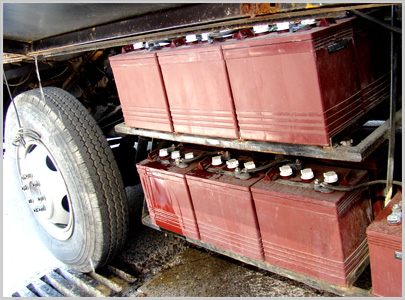
![]()
Double-Height
______________________________________________________
This laboratory is part of the
Mechanics and Energy Department.
It began operations in 1994.
The laboratory is run by
Dr. Ricardo Chicurel Uziel and
Mr. German Carmona Paredes.
It is located in building 12,
II UNAM. Ciudad Universitaria.
SCOPE
There are works related to technological developments involving construction of parts, assembly and testing of prototypes and their components. Projects focus on the development of electric vehicles and hybrids. The laboratory also carries out projects on hydraulic pumps and steam expanders, and development of electronic systems for motor control and battery charging.
ACTIVITIES
-
Minibuses "UNAM Electric Vehicle" and "Electrobus"
-
Delivery vehicle "Electrovira"
-
Development of an electric vehicle for distribution of goods (VER)
-
Several versions of the star bomb
-
Single palette pump
-
Low-speed impact meter for characterization of composite materials
-
One-fourth scale aircraft model for remote sensing
-
Conversion of a VW to electric drive
-
Development of parallel hybrid propulsion system for utility vehicles
-
Development of a motorcycle powered by hydrogen fuel cell
MAJOR WORKS AND RECENT PROYECTS
Development of a rotary steam expander
Design of vehicle Vehizero in conjunction with the company, and the production of the vehicle, in collaboration with engineers from the company.
EQUIPMENT
The lab has space where it is possible to work simultaneously with two van-type units. It has an absorption dynamometer bench of 75 HP, which is able to test electric motors or internal combustion engines; it also has a furnace for the manufacturing of composite laminates.
In one part of the lab, the following tools and machines are installed: two lathes, a milling machine, milling drill, a circular saw, an electric welder and other various tools.
It also has the equipment for battery charging and five working groups. The facility has three-phase power supply of 220 volts and compressed air. For testing composite materials and polymers, it has a free fall impact meter that was developed to study the dynamics of the fracture of composite materials that have to be impacted at low speed. The device consists of a system to place different points of impact sensors, a sample holder with two clear circular fasteners with a span of 200 cm2 and a minimum free fall mass of 3.5 kg. The data recorded during the impact is arranged, recorded and stored on a 500 MHz oscilloscope, to be then analyzed on a PC.